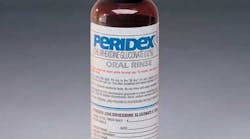By Ellen S. Neuenfeldt, RDH, BS
Chlorhexidine gluconate oral rinse can significantly reduce plaque bacteria and prevent the development of gingivitis.(1,2,3,4,5,6) A study estimates that over 50% of the adult population in the USA suffers from gingivitis on an average of 3 to 4 teeth.(7)
How does chlorhexidine gluconate work to treat gingivitis? Chlorhexidine gluconate has a positive chemical charge; it is attracted to the negative charge on certain bacteria in the mouth. This attraction affects the bacterial cell membrane and causes increased permeability for immediate antimicrobial activity. Chlorhexidine gluconate is also attracted to negatively charged surfaces on oral tissue. This additional attraction gives chlorhexidine gluconate a sustained action that can help prevent the formation of plaque.(8)
Chlorhexidine gluconate oral rinse therapy should be initiated directly following a dental prophylaxis in patients with gingivitis. The usual dose is 15 ml of undiluted chlorhexidine gluconate oral rinse, swished in the mouth for 30 seconds, and expectorated. Patients should be instructed to repeat this regimen twice a day, morning and evening after toothbrushing. Patients should not rinse the mouth with water or other mouthwashes or eat immediately after the use of chlorhexidine gluconate.(9)
The duration of treatment with chlorhexidine gluconate depends on each patient’s unique situation. While some patients may need a short course of therapy, others may require a longer treatment. Patients should be reevaluated at intervals no longer than six months to determine the need to continue with chlorhexidine gluconate therapy to treat gingivitis.(1,9)
The immediate antimicrobial activity of chlorhexidine gluconate can be beneficial to the dental professional as well as to the patient. Several studies support the use of a chlorhexidine gluconate pre-rinse to decrease bacterial aerosol contamination during in-office dental procedures.(10,11,12,13)
Although recommendations differ as to the optimum dosing regimen, studies suggest two consecutive 30-second periods of pre-procedural rinsing to reduce a patient’s salivary bacteria. This regimen has been found to immediately reduce the salivary bacterial load 97%, with continued results throughout a dental procedure.(10,11)
The most frequently prescribed chlorhexidine gluconate oral rinse is Peridex, available from 3M ESPE. Peridex was the first chlorhexidine gluconate oral rinse on the market and has over 20 years of clinical proof. Peridex is indicated for use between dental visits as part of a professional program for the treatment of gingivitis as characterized by redness and swelling of the gingivae, including gingival bleeding upon probing. Peridex reduces certain aerobic and anaerobic bacteria from 54-97% through six months of use. Peridex shows no significant changes in bacterial resistance or adverse changes in the oral microbial ecosystem. Peridex is supplied in 4-ounce, 16-ounce, and 64-ounce bottles. The product is available to patients through their dental office or by prescription.* In summary, chlorhexidine gluconate oral rinse has been extensively studied as an antimicrobial agent, both for the treatment of gingivitis and as a pre-procedural rinse. *See the full prescribing information provided with each bottle of Peridex or available at www.3MESPE.com. The clinical effectiveness and safety of Peridex has not been established in children under the age of 18 years old. The most common side effect of chlorhexidine gluconate is tooth staining which can be removed by a prophylaxis procedure.References
1. Overholser CD, Meiller TF, DePaola LG, Minah GE, Niehaus C. Comparative effects of 2 chemotherapeutic mouthrinses on the devopment of supragingival dental plaque and gingivitis. J Clin Periodontol 1990;17(8):575-579.2. Charles CH, Mostler KM, Bartels LL, Mankodi SM. Comparative antiplaque and antigingivitis effectiveness of a chlorhexidine and an essential oil mouthrinse: 6-month clinical trial. J Clin Periodontol 2004;31(10):878-884.3. Loe H, Schiott CR. The effect of mouthrinses and topical application of chlorhexidine on the development of dental plaque and gingivitis in man. J Periodont Res 1970;5:79-83.4. Banting D, Bosma M, Bollmer B. Clinical effectiveness of a 0.12% chlorhexidine mouthrinse over two years. J Dent Res 1989;68:1716-1718.5. Siegrist BE, Gusberti FA, Brecx MC, Weber HP, Lang NP. Efficacy of supervised rinsing with chlorhexidine digluconate in comparison to phenolic and plant alkaloid compounds. Jour of Periodont Res 1986;16:60-73.6. Gultz J, Kaim JM, DeLeo J, Scherer W. An in vivo comparison of the antimicrobial activities of three mouthrinses. J Clin Dent 1998;9:43-45.7. Oliver RC, Brown LJ, Loe H. Periodontal diseases in the United States population. J Periodontol 1998 69(2):269-278.8. Chlorhexidine Gluconate. AHFS Drug Information 2005. 9. Peridex (chlorhexidine gluconate 0.12% oral rinse ) prescribing information, June 2009.10. Veksler AE, Kayrouz GA, Newman MG. Reduction of salivary bacteria by pre-procedural rinses with chlorhexidine 0.12%. J Periodontol 1991;62:649-651.11. Logothetis DD, Martinez-Welles JM. Reducing bacterial aerosol contamination with a chlorhexidine gluconate pre-rinse. J Am Dent Assoc 1995;126:1634-1639.12. Szymanska J. Dental bioaerosol as an occupational hazard in a dentis’s workplace. Ann Agric Environ Med 2007;14:203-207.13. Harrel SK, Molinari J. Aerosols and splatter in dentistry: A brief review of the literature and infection control implications. JADA 2004;135:429-437.








